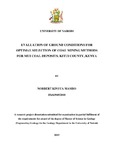| dc.description.abstract | It is vital to establish scientific methods towards optimally mining coal to increase efficiency in knowledge and profitability. This project aimed to determine the ground conditions for coalmines development at Block C. Block C (an exploration area that covers about 131Km2) is the contemporary coal frontier in Kenya that spans from Kateiko (North) to Yoonye (South) in Kitui County, Kenya. This coal, once mined will be used to harness national development which requires much electrical power energy to maintain.
In this project, known geological information and studies involving X-Rays fluorescence (XRF), apparent resistivity (VES) and unconfined compressive strength (UCS) were used to determine the ground conditions. Based on these studies, the challenges of coal mining and the applicability of open cast and subsurface mining methods at project sites were assessed.
Rock specimens that were used in this project were retrieved from coal boxes which are stored in a shed in Mathuki, Kitui County. Uniform compressive forces were used to press these specimens at constant rates. Measurements were recorded at failure points for the specimens and used in UCS computations. The harder specimens were analysed using the Dennison 2000kN Compression machine while the softer specimens were analysed in the UNESCO 50kN flexural loading/transverse frame loading machine. Next, the same specimens were dried in an oven at about 105°C for one hour and analysed for major elemental oxides contents using Shimadzu’s energy dispersive XRF spectrometer and its proprietary FP software. Also, VES data (earlier acquired using SARIS Terrameter) were analysed using RES 1-D software.
The findings from this study shows that mudstones are the weakest rocks with UCS values ranging from 82.504 to 3,490.92kN/m2. Shales are the strongest with UCSs ranging from 1,218.09 to 37,211.91kN/m2. XRF analysis enabled the reclassification of majority of the specimens into muddy sandstones and two unique classifications. These are marlstones (previously silty sandstones) and shaley ironstones (previously muddy shales). The VES results revealed that the Commissioning Well’s area has the largest stratum with the highest apparent resistivity (457m layer with 50,000Ω-m). On the other hand, Yoonye well’s area has the largest stratum with the lowest apparent resistivity (492.5m layer with 0.45Ω-m). The isotropy of strata at Commissioning Well and FP 2 suggested that the optimal coal mining method here can be subsurface tunnelling. The anisotropy at FP 3, Katz. 3 and YO 2 suggested that large scaled open cast mining method can be suitable at these sites.
Keywords: Coal, XRF, VES, UCS, Mining | en_US |

